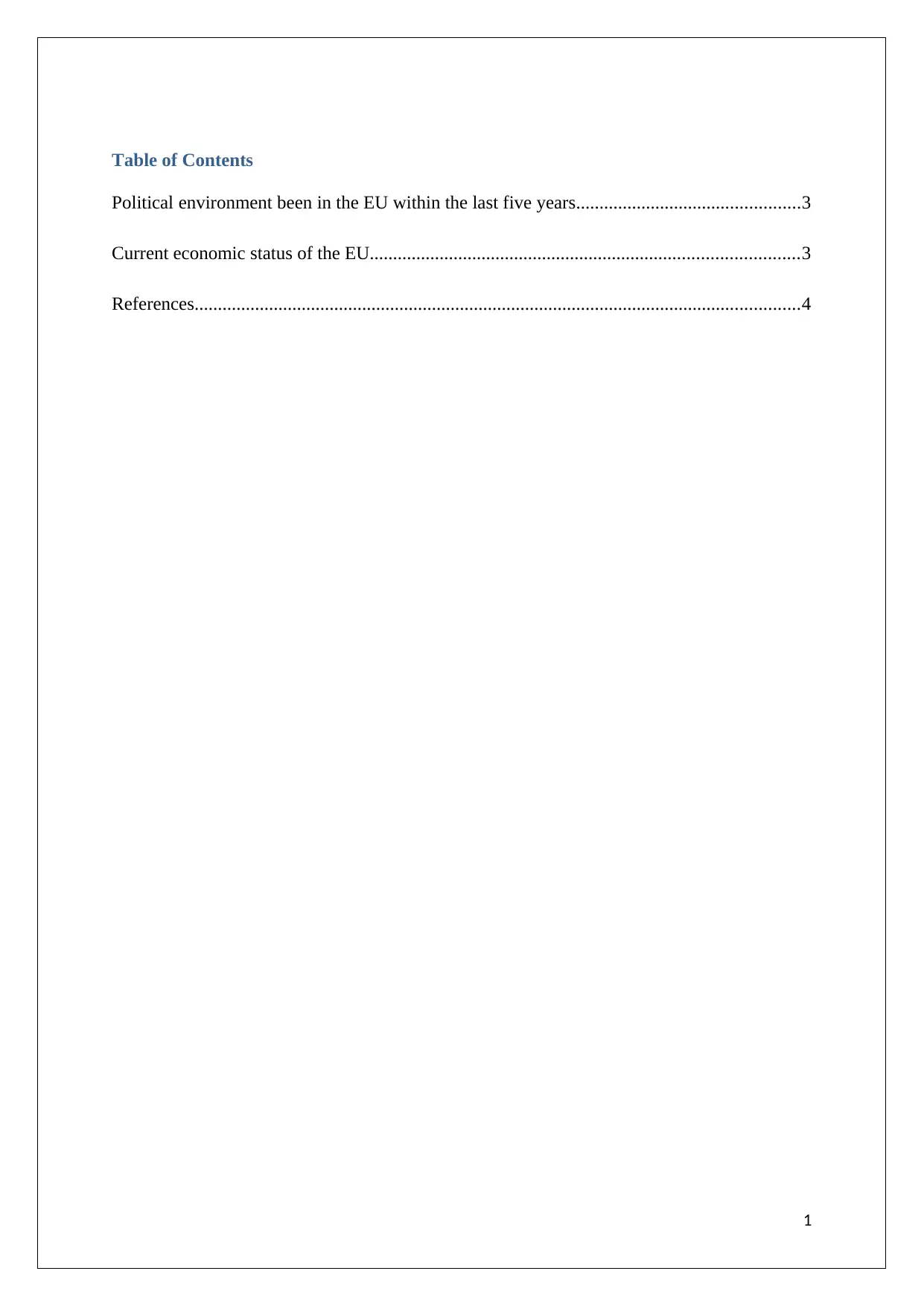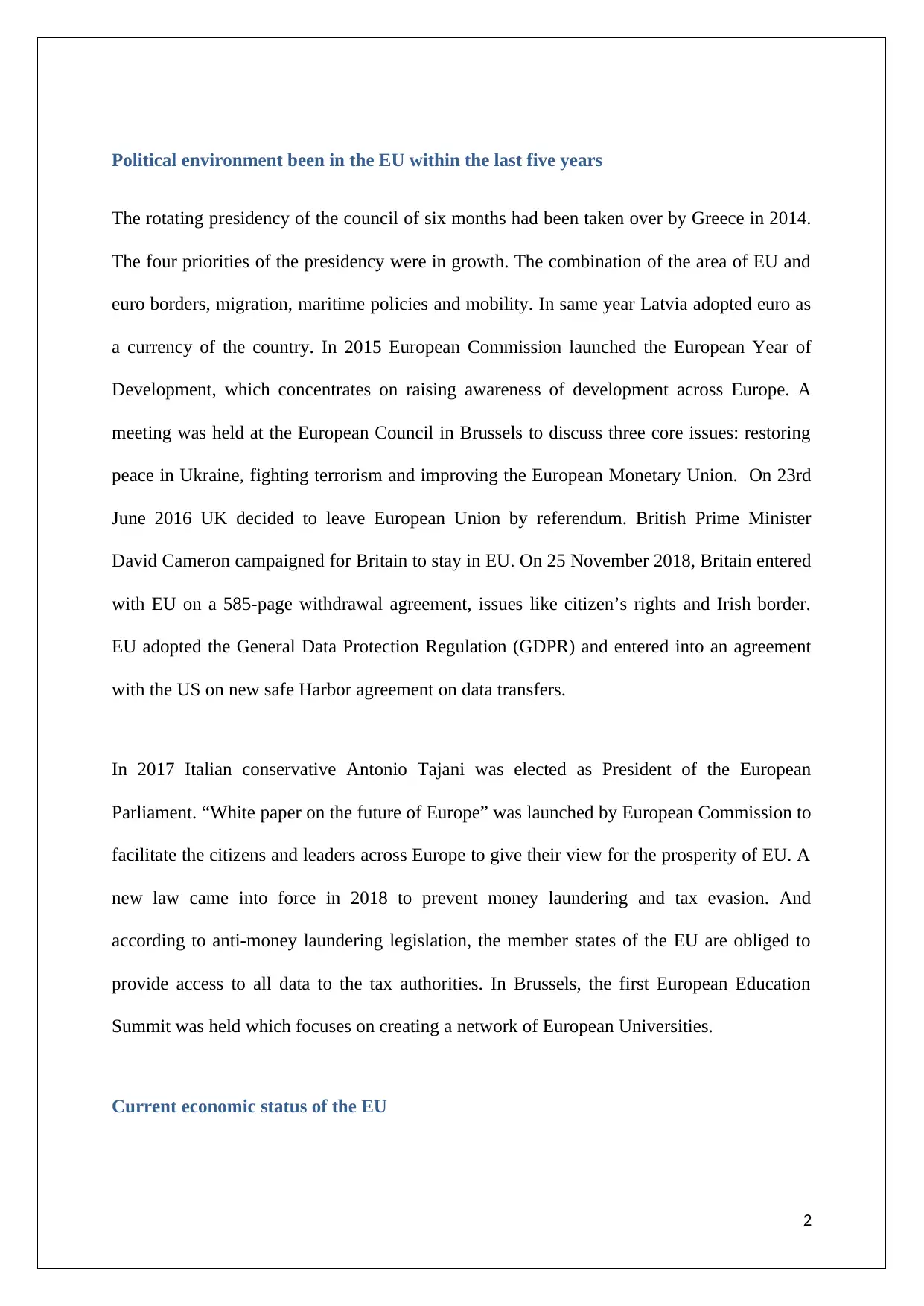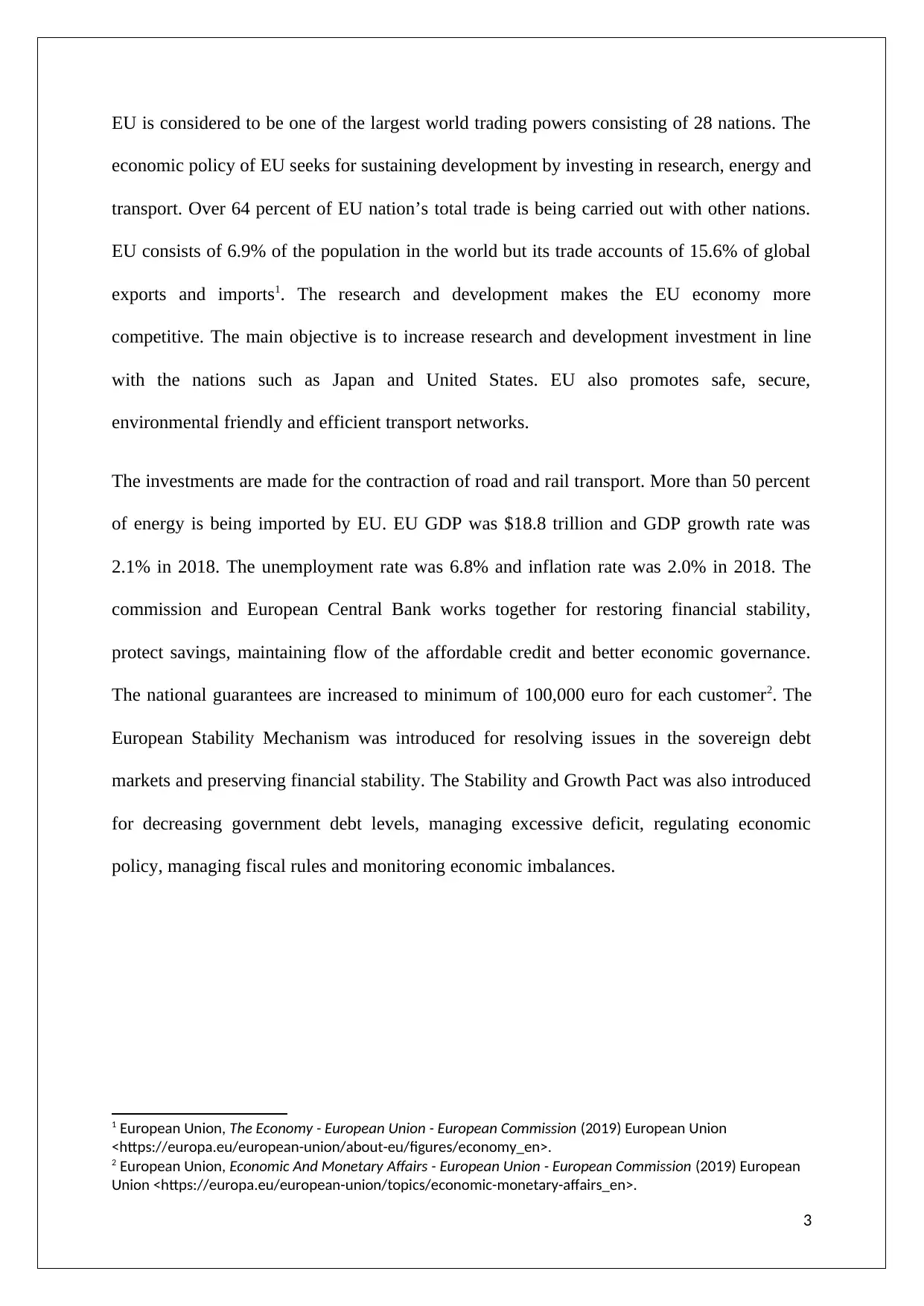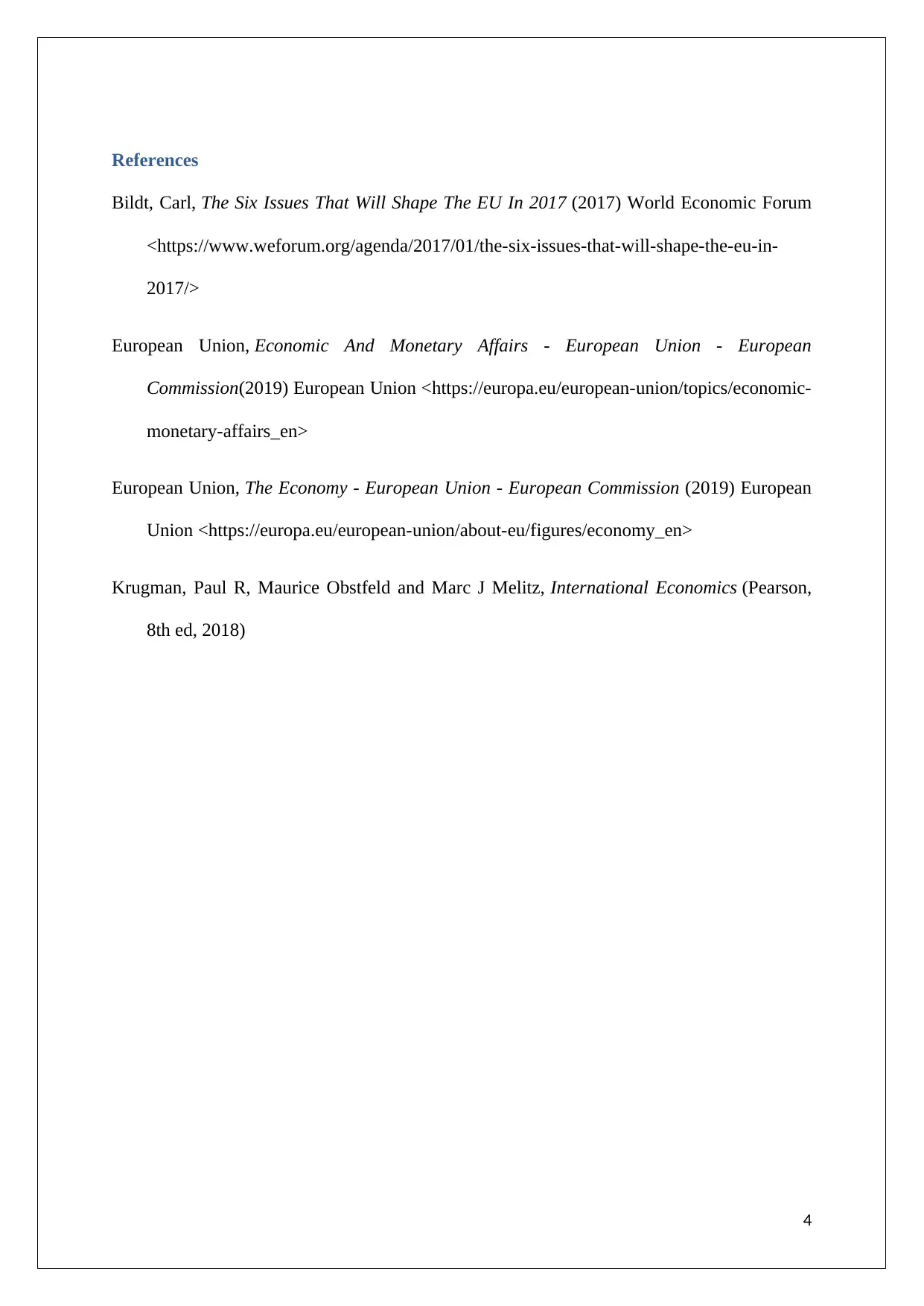Assessment of the EU: Political Environment and Economic Status
VerifiedAdded on 2023/04/24
|5
|757
|115
Report
AI Summary
This report provides an analysis of the European Union's political environment and economic status over the past five years. It highlights key political events such as Greece's presidency of the Council, Latvia's adoption of the Euro, the UK's decision to leave the EU (Brexit), and the implementation of the General Data Protection Regulation (GDPR). The report also examines the EU's economic status, including its position as a major world trading power, its focus on research and development, and its investments in transport and energy networks. Key economic indicators such as GDP, unemployment rate, and inflation rate are discussed, along with measures taken to restore financial stability and manage government debt. The report references sources from the World Economic Forum and the European Commission.

Finance
Paraphrase This Document
Need a fresh take? Get an instant paraphrase of this document with our AI Paraphraser

Table of Contents
Political environment been in the EU within the last five years................................................3
Current economic status of the EU............................................................................................3
References..................................................................................................................................4
1
Political environment been in the EU within the last five years................................................3
Current economic status of the EU............................................................................................3
References..................................................................................................................................4
1

Political environment been in the EU within the last five years
The rotating presidency of the council of six months had been taken over by Greece in 2014.
The four priorities of the presidency were in growth. The combination of the area of EU and
euro borders, migration, maritime policies and mobility. In same year Latvia adopted euro as
a currency of the country. In 2015 European Commission launched the European Year of
Development, which concentrates on raising awareness of development across Europe. A
meeting was held at the European Council in Brussels to discuss three core issues: restoring
peace in Ukraine, fighting terrorism and improving the European Monetary Union. On 23rd
June 2016 UK decided to leave European Union by referendum. British Prime Minister
David Cameron campaigned for Britain to stay in EU. On 25 November 2018, Britain entered
with EU on a 585-page withdrawal agreement, issues like citizen’s rights and Irish border.
EU adopted the General Data Protection Regulation (GDPR) and entered into an agreement
with the US on new safe Harbor agreement on data transfers.
In 2017 Italian conservative Antonio Tajani was elected as President of the European
Parliament. “White paper on the future of Europe” was launched by European Commission to
facilitate the citizens and leaders across Europe to give their view for the prosperity of EU. A
new law came into force in 2018 to prevent money laundering and tax evasion. And
according to anti-money laundering legislation, the member states of the EU are obliged to
provide access to all data to the tax authorities. In Brussels, the first European Education
Summit was held which focuses on creating a network of European Universities.
Current economic status of the EU
2
The rotating presidency of the council of six months had been taken over by Greece in 2014.
The four priorities of the presidency were in growth. The combination of the area of EU and
euro borders, migration, maritime policies and mobility. In same year Latvia adopted euro as
a currency of the country. In 2015 European Commission launched the European Year of
Development, which concentrates on raising awareness of development across Europe. A
meeting was held at the European Council in Brussels to discuss three core issues: restoring
peace in Ukraine, fighting terrorism and improving the European Monetary Union. On 23rd
June 2016 UK decided to leave European Union by referendum. British Prime Minister
David Cameron campaigned for Britain to stay in EU. On 25 November 2018, Britain entered
with EU on a 585-page withdrawal agreement, issues like citizen’s rights and Irish border.
EU adopted the General Data Protection Regulation (GDPR) and entered into an agreement
with the US on new safe Harbor agreement on data transfers.
In 2017 Italian conservative Antonio Tajani was elected as President of the European
Parliament. “White paper on the future of Europe” was launched by European Commission to
facilitate the citizens and leaders across Europe to give their view for the prosperity of EU. A
new law came into force in 2018 to prevent money laundering and tax evasion. And
according to anti-money laundering legislation, the member states of the EU are obliged to
provide access to all data to the tax authorities. In Brussels, the first European Education
Summit was held which focuses on creating a network of European Universities.
Current economic status of the EU
2
⊘ This is a preview!⊘
Do you want full access?
Subscribe today to unlock all pages.

Trusted by 1+ million students worldwide

EU is considered to be one of the largest world trading powers consisting of 28 nations. The
economic policy of EU seeks for sustaining development by investing in research, energy and
transport. Over 64 percent of EU nation’s total trade is being carried out with other nations.
EU consists of 6.9% of the population in the world but its trade accounts of 15.6% of global
exports and imports1. The research and development makes the EU economy more
competitive. The main objective is to increase research and development investment in line
with the nations such as Japan and United States. EU also promotes safe, secure,
environmental friendly and efficient transport networks.
The investments are made for the contraction of road and rail transport. More than 50 percent
of energy is being imported by EU. EU GDP was $18.8 trillion and GDP growth rate was
2.1% in 2018. The unemployment rate was 6.8% and inflation rate was 2.0% in 2018. The
commission and European Central Bank works together for restoring financial stability,
protect savings, maintaining flow of the affordable credit and better economic governance.
The national guarantees are increased to minimum of 100,000 euro for each customer2. The
European Stability Mechanism was introduced for resolving issues in the sovereign debt
markets and preserving financial stability. The Stability and Growth Pact was also introduced
for decreasing government debt levels, managing excessive deficit, regulating economic
policy, managing fiscal rules and monitoring economic imbalances.
1 European Union, The Economy - European Union - European Commission (2019) European Union
<https://europa.eu/european-union/about-eu/figures/economy_en>.
2 European Union, Economic And Monetary Affairs - European Union - European Commission (2019) European
Union <https://europa.eu/european-union/topics/economic-monetary-affairs_en>.
3
economic policy of EU seeks for sustaining development by investing in research, energy and
transport. Over 64 percent of EU nation’s total trade is being carried out with other nations.
EU consists of 6.9% of the population in the world but its trade accounts of 15.6% of global
exports and imports1. The research and development makes the EU economy more
competitive. The main objective is to increase research and development investment in line
with the nations such as Japan and United States. EU also promotes safe, secure,
environmental friendly and efficient transport networks.
The investments are made for the contraction of road and rail transport. More than 50 percent
of energy is being imported by EU. EU GDP was $18.8 trillion and GDP growth rate was
2.1% in 2018. The unemployment rate was 6.8% and inflation rate was 2.0% in 2018. The
commission and European Central Bank works together for restoring financial stability,
protect savings, maintaining flow of the affordable credit and better economic governance.
The national guarantees are increased to minimum of 100,000 euro for each customer2. The
European Stability Mechanism was introduced for resolving issues in the sovereign debt
markets and preserving financial stability. The Stability and Growth Pact was also introduced
for decreasing government debt levels, managing excessive deficit, regulating economic
policy, managing fiscal rules and monitoring economic imbalances.
1 European Union, The Economy - European Union - European Commission (2019) European Union
<https://europa.eu/european-union/about-eu/figures/economy_en>.
2 European Union, Economic And Monetary Affairs - European Union - European Commission (2019) European
Union <https://europa.eu/european-union/topics/economic-monetary-affairs_en>.
3
Paraphrase This Document
Need a fresh take? Get an instant paraphrase of this document with our AI Paraphraser

References
Bildt, Carl, The Six Issues That Will Shape The EU In 2017 (2017) World Economic Forum
<https://www.weforum.org/agenda/2017/01/the-six-issues-that-will-shape-the-eu-in-
2017/>
European Union, Economic And Monetary Affairs - European Union - European
Commission(2019) European Union <https://europa.eu/european-union/topics/economic-
monetary-affairs_en>
European Union, The Economy - European Union - European Commission (2019) European
Union <https://europa.eu/european-union/about-eu/figures/economy_en>
Krugman, Paul R, Maurice Obstfeld and Marc J Melitz, International Economics (Pearson,
8th ed, 2018)
4
Bildt, Carl, The Six Issues That Will Shape The EU In 2017 (2017) World Economic Forum
<https://www.weforum.org/agenda/2017/01/the-six-issues-that-will-shape-the-eu-in-
2017/>
European Union, Economic And Monetary Affairs - European Union - European
Commission(2019) European Union <https://europa.eu/european-union/topics/economic-
monetary-affairs_en>
European Union, The Economy - European Union - European Commission (2019) European
Union <https://europa.eu/european-union/about-eu/figures/economy_en>
Krugman, Paul R, Maurice Obstfeld and Marc J Melitz, International Economics (Pearson,
8th ed, 2018)
4
1 out of 5
Related Documents
Your All-in-One AI-Powered Toolkit for Academic Success.
+13062052269
info@desklib.com
Available 24*7 on WhatsApp / Email
![[object Object]](/_next/static/media/star-bottom.7253800d.svg)
Unlock your academic potential
Copyright © 2020–2025 A2Z Services. All Rights Reserved. Developed and managed by ZUCOL.





